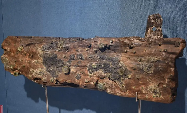Bronze Mirror Conservation in Fuxin, China: Preserving Ancient Artistry for Future Generations
Recently, archaeologists in Fuxin, China, have uncovered an exceptionally well-preserved bronze mirror from an ancient burial site dating back over 2,000 years. The discovery of such artifacts offers unparalleled insight into the cultural and technological practices of early Chinese civilizations. The bronze mirror, a common item in daily life during the Han Dynasty, was meticulously crafted with intricate patterns and inscriptions that provide valuable historical information about the people who used them.
The Fuxin excavation site has yielded numerous significant finds over the years, but this bronze mirror stands out for its exceptional condition and detailed design. According to Dr. Li Hua, the lead archaeologist at the site, "The mirror’s preservation is extraordinary. It still retains most of its original metallic shine and intricate decorative elements." This remarkable state of preservation is due in part to the specific environmental conditions within the burial chamber, which protected the mirror from corrosion over centuries.

To better understand the significance of this find, we reached out to experts in the field of Chinese archaeology, including Professor Zhang Ming of the National University of Singapore. Professor Zhang commented, "This mirror is not just an object; it’s a narrative. It tells us stories about the lives and beliefs of the people who made and used it. These discoveries help us piece together the complex puzzle of Chinese civilization’s past."
The conservation process for the mirror is underway at a specialized laboratory within the China National Museum. Specialists are using cutting-edge technology to preserve the mirror's delicate surface and prevent further deterioration. One method involves the use of advanced chemical solutions to remove corrosion while maintaining the artifact's structural integrity. Another key aspect of the project is digitization—creating detailed 3D scans and high-resolution images of the mirror for future research and educational purposes.
The team hopes to complete the restoration by mid-2025 and put the mirror on public display. In addition to showcasing the final product, they aim to create a virtual exhibition where visitors can interact with a digital version of the mirror and explore its historical context.
To learn more about Chinese archaeology and other discoveries around the world, visit Wikipedia.
 LongStory.Asia The Digital Archaeological Portal
LongStory.Asia The Digital Archaeological Portal